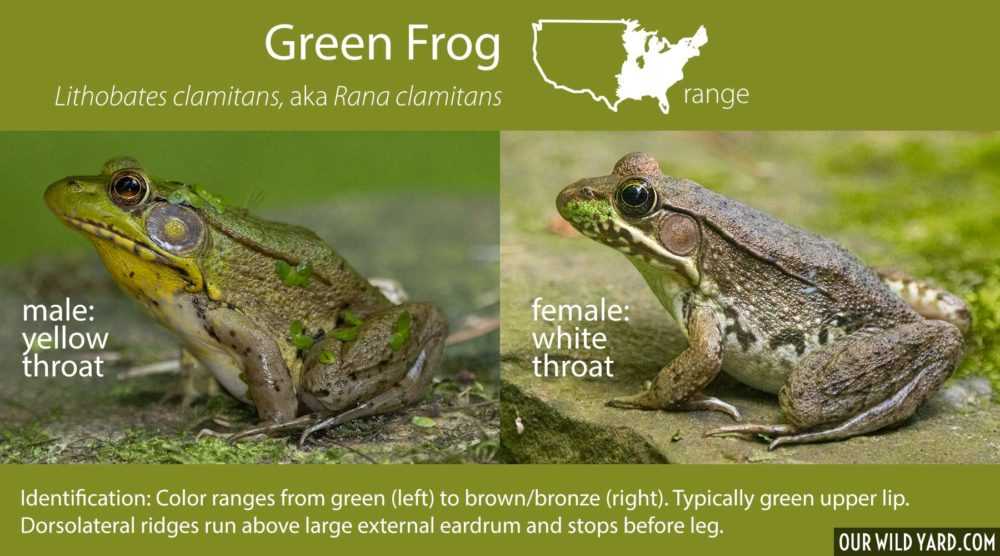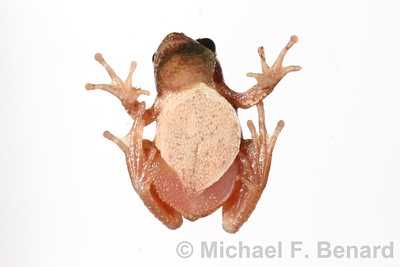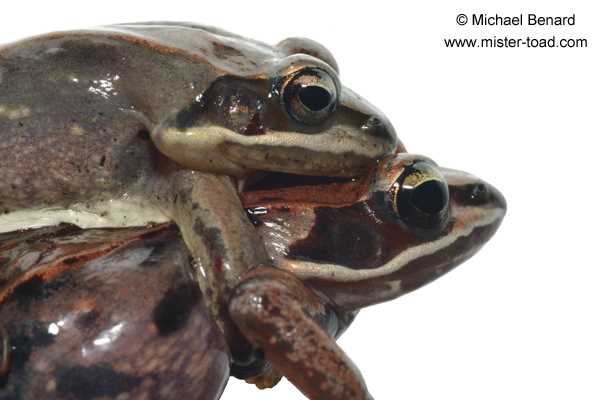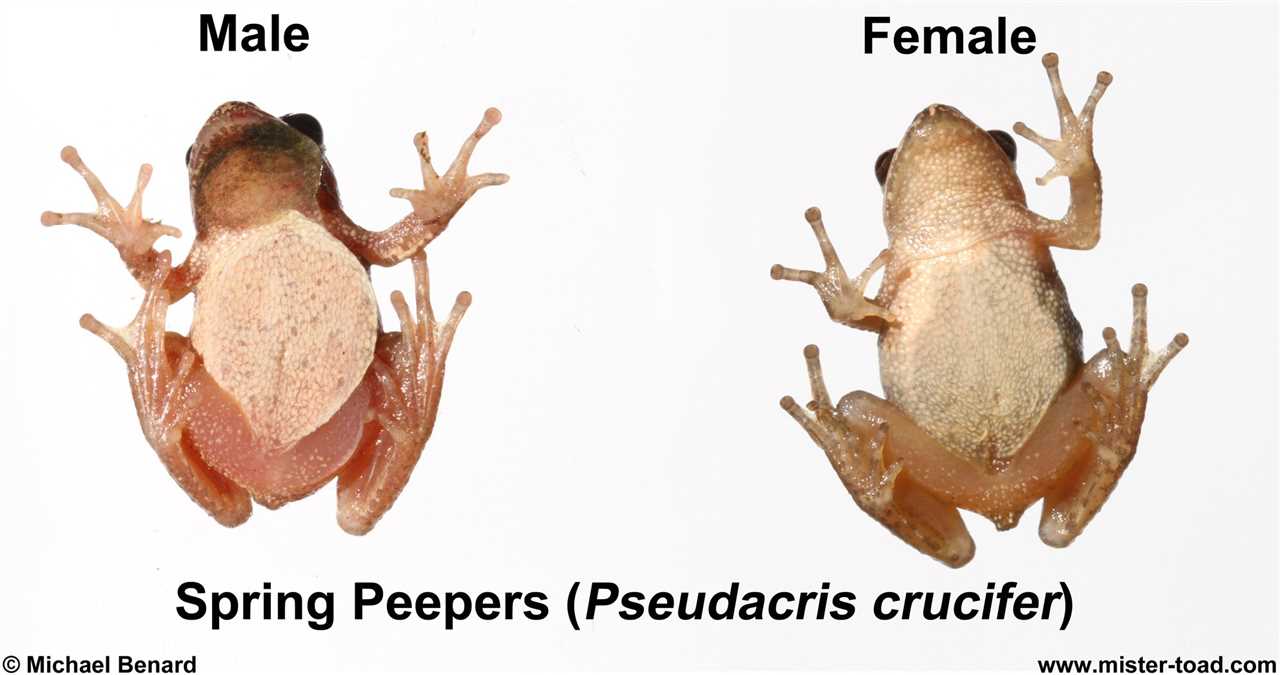One of the main characteristics that can help you identify the gender of a frog is its size. In most frog species, males tend to be smaller than females. This size difference can be subtle in some cases, but with careful observation, you will notice that the males are generally more petite and compact compared to the larger and bulkier females.
In addition to size, another clue to determine the gender of frogs is their appearance. Males often have certain physical traits that set them apart from females. For example, males may have vocal sacs, which are inflatable pouches located near their throat. These vocal sacs are used to amplify their mating calls and can be seen as small, swollen areas on the sides of their bodies.
Furthermore, the coloration and patterns on a frog’s body can also help in identifying its gender. In some species, males may have vibrant and bright colors, such as vivid greens, yellows, or blues, while females exhibit more muted tones. These striking colors in males are often associated with attracting females during the mating season and can make them easier to identify.
Why Identifying the Gender of a Frog is Important
Being able to identify the gender of a frog is crucial for several reasons. It allows researchers and scientists to understand the reproductive biology and behavior of frogs, which can provide valuable insights into their ecology and conservation. Furthermore, identifying the gender of frogs is important for breeding programs, as it allows for the selection of appropriate breeding pairs to maintain healthy populations and genetic diversity.
The Importance of being able to identify the sex of a frog
- Examining the external characteristics of a frog can often provide clues to its gender. Male frogs typically have vocal sacs and nuptial pads, while females lack these features.
- Differences in coloration between male and female frogs can also be used to identify their gender. For example, male frogs often have bright and vibrant colors to attract females during the breeding season.
- Behavioral differences can also be observed between male and female frogs. For example, males are often more territorial and aggressive, while females may exhibit nesting behavior or engage in parental care.
- Size and body shape can also be indicators of frog gender. In some species, males are smaller and have slimmer bodies compared to females.
- For tadpoles, techniques such as examining the shape of their tail or the presence of external gills can be used to determine their gender.
- DNA analysis can provide the most accurate method for determining the gender of a frog. By analyzing specific genetic markers, scientists can differentiate between male and female frogs.
Let’s start with the external features. One of the most prominent differences between male and female frogs is their size. Male frogs tend to be smaller and more slender, while females are generally larger and have a plumper body shape.
Another noticeable difference is in the coloration. Male frogs often have brighter and more vibrant colors, especially during the breeding season. This is because they need to attract females for mating. In contrast, female frogs typically have duller or more camouflaged colors to blend in with their surroundings and protect themselves from predators.
Examining the vocalizations of frogs is another way to determine their gender. Male frogs are well-known for their loud and distinctive calls, which they use to attract mates. Each species of frog has a unique call, allowing researchers or enthusiasts to identify the species and, in turn, the gender of the frog.
Behavioral differences also play a role in identifying the gender of frogs. For example, males often exhibit territorial behavior, defending a specific area within their habitat, while females tend to be more mobile and less territorial. Observing these behaviors can provide additional clues in deciphering the sex of a frog.
In some cases, DNA analysis may be necessary for accurate frog gender determination. This method is highly accurate and can provide definitive results, especially in cases where external characteristics are not enough to differentiate between male and female frogs.
External Characteristics for Determining the Gender of a Frog
1. Size:
2. Coloration:
Coloration is another important factor in determining frog gender. Male and female frogs often exhibit different colors or patterns on their bodies. For example, males may have brighter and more vibrant coloration, while females may have more muted or duller colors. These differences in coloration can help identify the gender of a frog.
| Males | Females |
|---|---|
| Bright and vibrant coloration | Muted or dull coloration |
| Distinct patterns or markings | Less pronounced patterns |
3. Vocalizations:
4. Physical features:
Physical features such as body shape and structure can also vary between male and female frogs. Male frogs may have certain physical characteristics that are absent in females, such as enlarged or swollen vocal sacs, which they use for amplifying their calls. Females, on the other hand, may have a rounder and broader body shape compared to males.
5. Behavior:
By carefully examining these external characteristics, including size, coloration, vocalizations, physical features, and behavior, it is possible to accurately determine the gender of a frog. This knowledge can be valuable for various research purposes, conservation efforts, and breeding programs.
Differences in Coloration between Male and Female Frogs
One of the most noticeable characteristics that can help identify and differentiate the gender of a frog is its coloration. Male and female frogs often have distinct color patterns and markings that can be used as reliable indicators of their gender.
In many frog species, males are typically more brightly colored than females. This difference in coloration is often attributed to the male’s need to attract a mate. The vibrant colors help male frogs stand out and catch the attention of potential female partners.
Male frogs may have bright, bold colors such as vibrant greens, yellows, blues, or reds. These colors are usually more intense and striking than those found on females. On the other hand, female frogs tend to have more subdued and earthy tones, such as browns, grays, or dull greens.
Additionally, male frogs may have distinct patterns or markings on their bodies that help further differentiate them from females. These patterns can appear as spots, stripes, or intricate designs. They can be found on various parts of the body, including the back, legs, throat, or head.
| Male Frog | Female Frog |
|---|---|
 |
 |
Examining the Vocalizations of Frogs for Gender Identification
On the other hand, female frogs generally do not produce loud calls like males. Their vocalizations are often softer and shorter, and they are mainly used as a response to the calls of male frogs. These female calls are usually a simple click or a series of short, high-pitched sounds.
Why are vocalizations important?
Vocalizations play a crucial role in frog communication and mating behavior. By listening to the calls of male frogs, females can determine the fitness and suitability of a potential mate. The calls provide information about the male’s size, health, and genetic quality.
Studying vocalizations can also be important for conservation efforts. It allows researchers to identify and monitor frog populations in the wild. Declining or changing vocal patterns can indicate ecological disruptions or habitat loss, giving valuable insights into the health and status of frog populations.
Methods for studying frog vocalizations
To study and differentiate between the vocalizations of male and female frogs, researchers use various methods. One common technique is the use of audio recording equipment. By placing microphones near water bodies or in frog habitats, researchers can capture and analyze the sounds produced by different individuals.
In addition to audio recordings, scientists also use spectrograms to visualize and analyze the frequency and duration of frog calls. This helps in identifying patterns and distinguishing between the calls of males and females.
Conclusion
Telling the Female from the Male: Ways to Identify the Gender of a Frog
Visual Cues
One of the primary ways to identify the gender of a frog is through the observation of external characteristics. Male frogs tend to be smaller and have slimmer bodies compared to their female counterparts. Additionally, certain species of frogs exhibit differences in coloration between the sexes, with males often having brighter and more vibrant colors to attract mates.
Vocalizations
Behavioral Differences
Male and female frogs also exhibit behavioral differences that can help in gender identification. Male frogs are typically more territorial and aggressive, while females may exhibit more passive behaviors during the mating season. These behavioral cues can provide valuable insights into the gender of frogs.
Factors affecting Gender Determination
Ethical Considerations
Lastly, ethical considerations should be taken into account when identifying the gender of frogs. Researchers and enthusiasts must prioritize the well-being and conservation of frogs, ensuring that any gender determination methods used are non-invasive and do not harm the frogs or their habitats.
Size and Body Shape as Indicators of Frog Gender
One of the main differences between male and female frogs is their size. In many frog species, females are typically larger than males. This size difference is most noticeable in adult frogs, but can also be observed in juvenile frogs. By comparing the size of a frog to typical size ranges for its species, we can often make an educated guess about its gender.
In addition to size, body shape can also provide clues about frog gender. Male frogs often have a more slender and streamlined body shape, while females tend to have a rounder and bulkier appearance. This difference in body shape is most evident in the abdominal region, where females may have a more distended belly due to the presence of eggs.
Visual Differences in Body Size and Shape
To better understand these visual differences, let’s compare the characteristics of male and female frogs in two common species: the Northern Leopard Frog and the American Bullfrog.
Northern Leopard Frog:

| Gender | Size | Body Shape |
|---|---|---|
| Male | 2.5-3.5 inches | Slender and streamlined |
| Female | 3.5-4.5 inches | Round and bulkier |
American Bullfrog:
| Gender | Size | Body Shape |
|---|---|---|
| Male | 3-6 inches | Slender and streamlined |
| Female | 6-8 inches | Round and bulkier |
Techniques for Identifying the Gender of Tadpoles
1. Cloacal Examination:
One technique for identifying the gender of tadpoles is through cloacal examination. The cloaca is a common opening for the excretory, reproductive, and digestive systems of amphibians. In male tadpoles, the cloaca is located closer to the tail and appears as a small vent. In female tadpoles, the cloaca is located closer to the belly and appears as a more rounded opening.
2. Abdominal Coloration:

Another technique involves observing the abdominal coloration of tadpoles. In some species, male tadpoles may exhibit brighter or more intense coloration in the abdominal area compared to females. This difference in coloration can be a reliable indicator of their gender.
3. Behavioral Differences:
Male and female tadpoles may also exhibit behavioral differences that can help in gender identification. For example, male tadpoles may be more active and engage in aggressive behavior, such as nipping at other tadpoles or chasing them. Female tadpoles, on the other hand, may be more passive and tend to stay close to vegetation for protection.
4. Size and Growth Rate:

Size and growth rate can also provide clues about the gender of tadpoles. In some species, males tend to grow at a faster rate and reach a larger size compared to females. By monitoring the growth rate and comparing the size of tadpoles, it may be possible to identify their gender.
5. Genetic Analysis:
In certain cases, genetic analysis may be needed to accurately determine the gender of tadpoles. DNA testing can be performed to identify specific genetic markers that differentiate between male and female tadpoles. This technique can provide a definitive answer when other methods are inconclusive.
Differentiate Male and Female Frogs: Utilizing DNA Analysis for Accurate Frog Gender Determination
Frogs exhibit a wide range of physical and behavioral differences between males and females, making it essential to accurately identify their gender for scientific research, conservation efforts, and breeding programs. Traditional methods of determining frog gender rely on external characteristics, vocalizations, and size and body shape. However, for a more precise and reliable assessment, DNA analysis is becoming an increasingly valuable tool.
The Importance of Accurate Frog Gender Determination
Utilizing DNA Analysis for Frog Gender Determination
DNA analysis offers a highly accurate and reliable method for determining the gender of frogs. This technique involves extracting DNA from a tissue sample, usually obtained through non-invasive methods such as toe clipping or mouth swabbing. Once the DNA is extracted, specific genetic markers, including sex-linked genes or regions, are amplified and analyzed.
One of the most commonly utilized methods is Polymerase Chain Reaction (PCR), which allows for the selective amplification of DNA sequences of interest. By targeting specific genetic markers associated with female or male frogs, researchers can differentiate between the two genders. These markers can include genes responsible for sex determination or chromosomal differences between males and females.
To analyze the amplified DNA, researchers employ techniques such as gel electrophoresis or DNA sequencing. Gel electrophoresis enables the visualization and comparison of DNA band patterns, allowing for a clear distinction between male and female frog samples. DNA sequencing provides more precise information about the genetic differences between male and female frogs, including the identification of specific mutations or genetic variations.
Advantages and Considerations
DNA analysis provides several advantages over traditional methods of gender determination. It allows for accurate assessment, even in situations where external characteristics, vocalizations, or size and body shape may not provide a clear distinction between male and female frogs. Additionally, DNA analysis can be performed at any life stage, including tadpoles, providing early identification of gender.
| Advantages of DNA Analysis for Frog Gender Determination | Considerations for Ethical Use of DNA Analysis |
|---|---|
| – High accuracy and reliability | – Prioritizing non-invasive sampling methods |
| – Suitable for all life stages | – Obtaining proper permits and following ethical guidelines |
| – Provides in-depth genetic information |
Male and Female Reproductive Organs in Frogs
In male frogs, the main reproductive organ is the testes, which are responsible for producing sperm. The testes are paired organs located in the abdominal cavity. They can be differentiated from the other internal organs by their whitish color and oval shape. Alongside the testes, there is a pair of small structures called the “biductal gland”. These glands produce a substance that helps to attach the sperm to the eggs during fertilization.
Differentiating Male and Female Frogs: Factors Affecting Gender Determination

2. Developmental stage: Some frogs undergo dramatic physical changes during their development, and these changes can affect the accuracy of gender determination. For example, male frogs may develop secondary sexual characteristics, such as enlarged vocal sacs or nuptial pads, during the breeding season.
3. Environmental factors: The environment in which a frog lives can influence its development and, consequently, its gender expression. Temperature, humidity, and overall environmental health can all impact the development of sexual organs and secondary sexual characteristics.
5. Seasonal variation: The appearance and behavior of frogs can change seasonally, particularly during the breeding season when males often exhibit more pronounced secondary sexual characteristics. These variations can make it easier to differentiate between male and female frogs during certain times of the year.
6. Size and body shape: While not always definitive, size and body shape can provide clues about the gender of a frog. In some species, females may be larger and have a stockier build, while males may be smaller and more streamlined.
Ethical Considerations in Identifying the Gender of Frogs
One of the main ethical concerns in identifying the gender of frogs is the potential harm that can be caused to the individual frogs. Some methods, such as invasive procedures or surgeries, can be invasive and may result in pain, stress, or even death for the frogs. It is essential to prioritize the well-being and welfare of the frogs throughout the process.
Another ethical consideration is the impact on frog populations. If identifying the gender of frogs involves capturing or handling large numbers of individuals, it could disrupt their natural behavior and potentially harm the population. This is especially important for endangered or vulnerable species, where every individual counts for the survival of the species.
It is also crucial to consider the purpose of identifying the gender of frogs. While it may be interesting from a scientific perspective or necessary for breeding programs, it is essential to weigh the potential benefits against the potential harm to the frogs. Is the information gained worth the potential negative effects on the frogs and their populations?
Furthermore, transparency and accountability are important ethical considerations. It is necessary to clearly communicate the purpose and methods of frog gender identification to the public and seek their input and feedback. This ensures that the decision-making process is transparent and that the public’s concerns and values are taken into consideration.
Overall, ethical considerations play a significant role in identifying the gender of frogs. It is essential to prioritize the well-being and welfare of the frogs, minimize harm, and consider the purpose and potential consequences of frog gender identification. By doing so, we can ensure that our actions are ethically sound and respectful towards these fascinating creatures.

I’m Lena Adams—a product of an unconventional upbringing in the African wilderness. My father, a daring explorer of African wildlife, sparked my fascination with reptiles, a passion that intertwined with the tragic loss of my mother during an expedition, leaving an indelible mark on my life. Driven to understand the creatures that captivated my parents, I embarked on my journey, sharing insights about reptiles, frogs, and lizards on my website. Through my explorations and conservation efforts, I honour my family’s legacy while seeking connections—to the creatures, nature, and the mother whose presence I yearn to understand.
